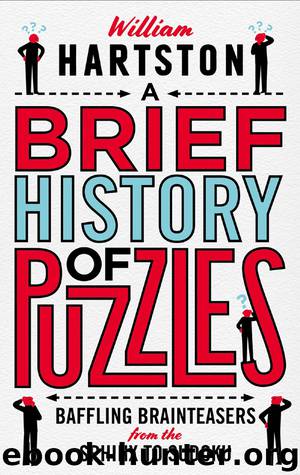A Brief History of Puzzles by William Hartston

Author:William Hartston
Language: eng
Format: epub
Publisher: Atlantic Books
A man buys a parrot in a pet shop which the owner has assured him will repeat any word it hears. On getting the parrot home and talking to it, however, the man is rewarded with total silence. So he takes the parrot back to the shop and demands a refund. The pet shop owner refuses, on the grounds that what he said was perfectly true. Explain.
PUZZLE 88
If two’s company and three’s a crowd, what is four and five?
Let’s return from riddle ridiculous to the sublimeness of Smullyan. Some of his best logical problems stemmed not from a short story but from an old puzzle about a liar and a truth-teller. I believe that they originally took the form of two guards at a fork in the road. One direction led to heaven, the other to hell and a traveller is permitted to ask only one question of only one of the guards. The trouble is that one of them always tells the truth, the other always lies and the traveller does not know which is which.
There are several possible solutions, of which the usual one given is to point to one of the guards and ask the other one, ‘Which road would your companion say leads to heaven?’ Whichever road is given as the answer, the traveller should then take the other one. Even simpler, the traveller could ask: ‘What answer would you give if I asked which road leads to heaven?’ and then follow the answer given.
Smullyan hugely developed this theme, dropping the heaven and hell tale but setting his logical dilemmas on an island populated by knights, who always tell the truth, and knaves, who always lie. In his 1987 book Forever Undecided, he uses this puzzle approach to explain and prove Gödel’s incompleteness theorem, which was one of the most complex and far-reaching discoveries in logic and philosophy in the twentieth century. Despite his light-hearted approach, Smullyan’s book soon veers into the language and symbolism of propositional logic, but to introduce the reader to ideas of truth, falsehood and unprovability, he starts with a few knight and knave puzzles. Here are three early examples.
PUZZLE 89
Download
This site does not store any files on its server. We only index and link to content provided by other sites. Please contact the content providers to delete copyright contents if any and email us, we'll remove relevant links or contents immediately.
Harry Potter and the Cursed Child: The Journey by Harry Potter Theatrical Productions(3954)
The Sports Rules Book by Human Kinetics(3581)
Molly's Game: From Hollywood's Elite to Wall Street's Billionaire Boys Club, My High-Stakes Adventure in the World of Underground Poker by Molly Bloom(2962)
A Knight of the Seven Kingdoms by George R R Martin(2620)
Quidditch Through the Ages by J.K. Rowling(2566)
Quidditch Through the Ages by J K Rowling & Kennilworthy Whisp(2557)
How To by Randall Munroe(2466)
Quidditch Through the Ages by Kennilworthy Whisp by J.K. Rowling(2404)
Quidditch through the Ages by J. K. Rowling(2351)
Quidditch Through The Ages by J. K. Rowling(2314)
Stacked Decks by The Rotenberg Collection(2266)
776 Stupidest Things Ever Said by Ross Petras(2264)
What If?: Serious Scientific Answers to Absurd Hypothetical Questions by Randall Munroe(2166)
Flowers For Algernon by Daniel Keyes(2153)
Beautiful Oblivion by Jamie McGuire(2136)
The Book of Questions: Revised and Updated by Gregory Stock Ph.d(2136)
The Infinite Retina by Robert Scoble Irena Cronin(2134)
Champions of Illusion by Susana Martinez-Conde & Stephen Macknik(2073)
Ready Player One: A Novel by Ernest Cline(2070)
